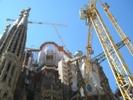
La Sagrada's Second Century
Seeing modern tower cranes at work and scaffolding surrounding the soaring spires of Barcelona's Sagrada Familia, Antoni Gaudi's magnificent basilica, is a reminder of safety's worldwide importance and progress.
- By Jerry Laws
- Aug 01, 2011
BARCELONA, Spain -- Can it ever be finished? Work goes on atop Barcelona's magnificent, majestic Sagrada Familia, with an array of modern tower cranes lifting materials so that construction workers wearing the latest PPE can continue raising one of the world's tallest and most unusual churches, a modernist masterpiece designed by architect Antoni Gaudi, whose works strongly echo natural forms and are major tourist attractions for this bustling city.
Drawing hundreds of thousands of visitors annually, the basilica has been under construction for more than a century, with completion expected sometime within the next 20 years. Its bright, vast interior -- marked by treelike great columns in varying sizes that are fashioned from four different stones -- looks all but finished. The modern tools, scaffolding, and protective equipment in use by its builders are reminders of safety's worldwide importance and progress and of the enduring popularity of Gaudi, who is buried in its crypt.
Born in June 1852, he was given the job of architect of the Sagrada Familia Temple in March 1883. Gaudi scholars say he dedicated much of his professional life thereafter to the project, including the final 12 years of his life, from 1914 to 1926. The project has taken so long because from the outset, its founders decreed that it be funded solely by donations -- causing Gaudi, who lived on the site for some time, to seek funds on his own, and stopping the work more than once.
His vision for the basilica will be completed when the last of 18 bell towers is finished, towering more than 100 meters above the main structure.
To me, visiting Gaudi's greatest masterpiece and his resting place there brought to mind the epitaph on the tomb of the architect Christopher Wren inside St. Paul's Cathedral in London: "Lector, si monumentum requiris circumspice." (Reader, if you seek his monument, look around.)
About the Author
Jerry Laws is Editor of Occupational Health & Safety magazine, which is owned by 1105 Media Inc.